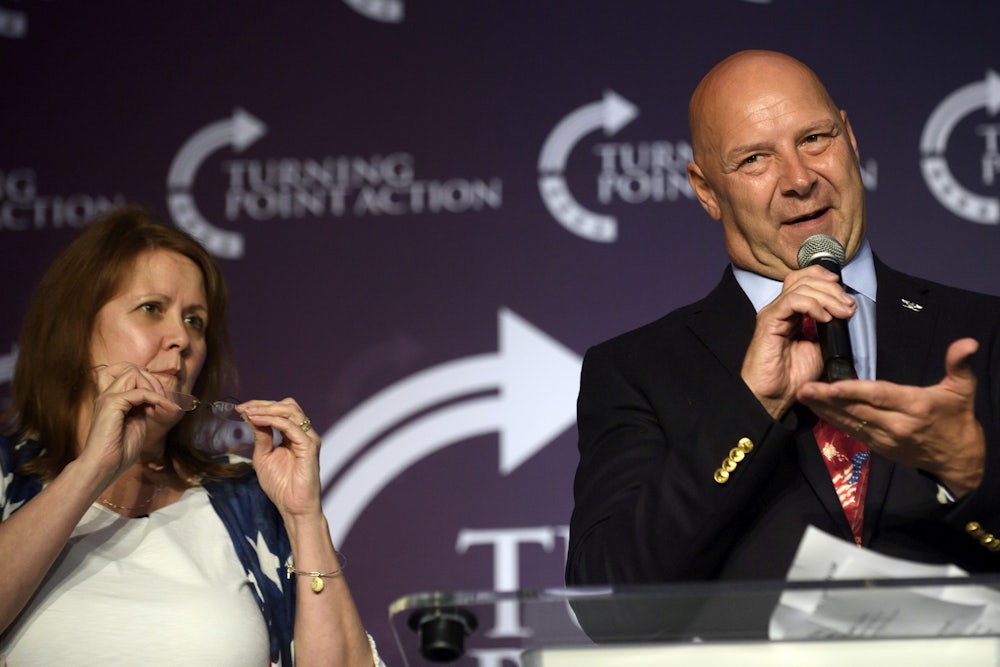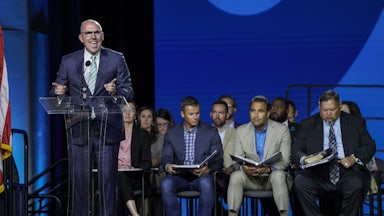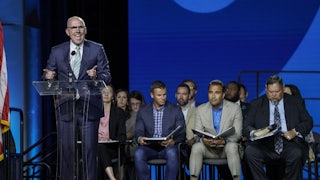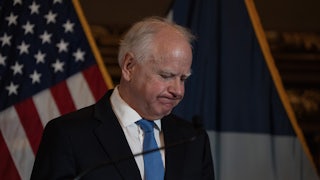On 20 January, 1994, a group of 120 churchgoers at Toronto Airport Vineyard Church fell to the floor in hysterical laughter, some of them barking like dogs and roaring like lions.
Randy Clark, the visiting preacher from St. Louis who sparked the outburst, proudly described them as “drunk” on the Holy Spirit. But that raucous week sparked what’s come to be known as the Toronto Blessing, a twelve-and-a-half-year revival that attracted visitors from scores of countries to a crusade that, 30 years later, has transformed into what might be the most influential force in Christianity today: the New Apostolic Reformation. And they have one clear goal in mind—ruling over the United States and, eventually, the world.
NAR, as it’s often called, is a shadowy movement, rather than an organization; many who are considered a part of it deny that it even exists. Broadly, it seeks to return church structures to the fivefold ministry of the Bible (defined roles of apostle, prophet, evangelist, pastor, and teacher). The key roles in this pecking order are prophets, who have the visions, and apostles, the anointed ones who put ideas and networks into practice and, critically, to whom everyone else must submit.
While it all sounds rather dull and bureaucratic, the NAR is all about establishing new hierarchies, a dry run for how it wants to take control of society. Theology professor André Gagné, who follows the movement closely, says that “the NAR is inherently political, it’s in their DNA.” Practicing what it preaches, he says the movement is “dominionism in and of itself—bringing about God’s Kingdom in these networks.”
Emerging out of the Pentecostal and Charismatic movements, which account for some 600 million Christians worldwide, the New Apostolic Reformation has arguably become the center of gravity in modern American Christianity. It’s hell-bent on energizing believers for the End Times: Church is no longer something you attend on Sunday—it’s a place to orchestrate the radical transformation of society. Now NAR is becoming increasingly influential within the Republican Party.
Pennsylvania Republican gubernatorial nominee Doug Mastriano might currently be the movement’s best-known political proponent. A January 6 insurrectionist, he has campaigned with Prophet Julie Green, who promotes conspiracies—including one rather grotesque story alleging that House Speaker Nancy Pelosi regularly drinks children’s blood. Mississippi Governor Tate Reeves and his Secretary of State Michael Watson have attended prayer events with NAR figures, while Ron DeSantis, the Catholic Florida governor, has been employing rhetoric popular with the movement to “put on the full armor of God.”
They’re joined by a coterie of well-known political extremists aligning with these modern-day apostles to subvert democratic rule, including Marjorie Taylor Greene, Lauren Boebert, Michael Flynn, Roger Stone, and Turning Point USA leader Charlie Kirk. Sure, they form the usual list of media tarts who regularly push the boundaries of anything offensive to liberal sensibilities, but their relationship to NAR is no mere flirtation.
Behind them, the leaders of this modern Reformation are deadly serious. A quick scan of recent political violence is telling. Two of the most influential modern apostles, Che Ahn and Lance Wallnau, helped rile up the crowds at pro-Trump, anti-democratic “Jericho marches” and prayer rallies before the storming of the Capitol on January 6, 2021. This is not to say that NAR influence is simply an expression of theological MAGA: There is a long history of entwinement with the Republican Party. Once-mainstream figures such as Sarah Palin and Rick Perry were signed up to churches preaching this radical bent on faith when they were running for the highest office in the land.
In order to understand the movement trying to take over the U.S. today, we need to go back to 1947, when a small movement known as the New Order of the Latter Rain began praying and fasting in Saskatchewan, Canada, which took on the established Pentecostal authority, not even 50 years old. Latter Rain leaders wanted to practice the powers gifted by the Holy Spirit to Jesus’s disciples—such as casting out demons, healing the sick, and raising the dead—and critically, they wanted to do it on demand, rather than waiting for these gifts to be bestowed upon them.
It’s little wonder that ideas of instant religious gratification and rejection of central authority appealed to what’s known as the second wave of the Holy Spirit, led by disaffected New Agers in 1960s California. An influential figure in the movement (and incidentally, a founding member of the Righteous Brothers), John Wimber, who went on to lead the Vineyard movement of which the Toronto church was a part, advocated for “power evangelism”—that is, practicing the miracles of the Holy Spirit or, as he preferred to call it, “doin’ the stuff.”
Though Wimber eventually tried to tame the lion roarers and carpet rollers of Toronto, his key disciple, C. Peter Wagner, saw an opportunity in 1996 to reestablish some of the ideas put forward by the Latter Rain movement, with a few more of his own, including breaking away from existing structures and establishing a new denomination, practicing demonology, and embracing the transnational and commercial focus of the Neocharismatic movement, or third wave of the Holy Spirit.
After falling out with Wimber, Gagné says that Wagner “took a turn which embraced more of what had emerged from the Toronto Blessing and subsequent revivals.” Wagner, who coined the term New Apostolic Reformation, was intent on pushing boundaries, proclaiming that “we are currently witnessing the most radical change in the way of ‘doing church’ since the Protestant Reformation.” So while authority and structure is critical to Wagner and his disciples in establishing the hierarchy of the NAR, two key concepts central to the movement are where we see its leaders exert their authority.
The first is “spiritual warfare,” the emphasis on demonology over which Wimber and Wagner split, which holds that demons and evil spirits are present and intervening in our daily lives. Seemingly bizarre utterances, from Paula White Cain urging the termination of “all satanic pregnancies” and anti-vax doctor Stella Immanuel calling Covid “demon sperm,” are spiritual warfare terms, intended to highlight a spiritual conception of the world that is meaningful in global NAR circles and beyond. Here, sickness and poverty aren’t physical, they are the result of being possessed by demons.
Among adherents, there’s a real valence to this idea during bad times, but Wagner and his acolytes have added a more important “level” of spiritual warfare on top of these preexisting beliefs. They have introduced the concept of “territorial spirits,” demons who occupy places and institutions “strategically”—think abortion clinics, the LGBT community, or the Democratic Party. These malevolent forces don’t simply advocate for things that believers oppose—they are evil personified, and need to be cleansed.
Demonizing your enemies is a dangerous idea, and it’s not for everyone. A more politically friendly doctrine is available for those who require more direct inspiration. The Seven Mountain Mandate, or 7M for short, is heavily fortifying many on the radical right of American politics. It calls on right-thinking Christians to conquer the seven mountains or “spheres of influence” in culture and society: education, religion, family, business, government, arts, and entertainment. Popular with hypermasculine, gun-toting types, 7M has encouraged believers to invade “mountains”—including the U.S. Capitol and local school boards.
Apostles Lance Wallnau and Bill Johnson, authors of 7M manifesto Invading Babylon, are explicit about what this means for America. For them, the “business of shifting culture or transforming nations does not require a majority of conversions.” Instead of winning a consensus, “we need more disciples in the right places, the high places. Minorities of people can shape the agenda, if properly aligned and deployed.”
Recently, an event in Atlanta called FlashPoint Live saw a group of prophets and apostles, including Wallnau, citing the “Watchman Decree,” which included declarations to “stand against wokeness, the occult, and every evil attempt against our nation” and to “take back influence at the local level in our communities.”
Another series of live rallies, the Reawaken America Tour sponsored by NAR’s key organ, Charisma News, is currently touring the country. Speakers, who have included former Trump national security adviser Michael Flynn, extreme Arizona state legislator Wendy Rogers, and anti-lockdown activist and musician Sean Feucht, are moving into the MAGA energy vacuum by combining politics, QAnon conspiracy, and Charismatic Christian beliefs in one amped-up and paranoid far-right ecosystem. (During his religious and political turn, Kanye West performed at its predecessor, Awaken 2020.) It’s probably no coincidence that Reawaken America, which has largely toured red states, finishes in Pennsylvania in late October, just weeks before election day in Mastriano’s state.
Separately and together, NAR beliefs such as 7M and spiritual warfare are emboldening those who claim that America is a Christian nation and that they have a mandate from God to rule. It is Christian dominionism for the twenty-first century, and there’s little wonder that petty tyrants like Michael Flynn and Mike Lindell are aligning with NAR leaders. These religious entrepreneurs have become political entrepreneurs and are fortifying a broad coalition of the radical right with the highest authority of all.
Yet while this movement is continuing to take shape, something curious is happening. While the people and ideas coming out of the New Apostolic Reformation are highly influential, many prominent people associated with the movement outright deny that it even exists—or claim that if it does, they’re not a part of it.
Unlike Christian nationalism—a pejorative term about taking America back for God that swathes of the right are now adopting as a badge of honor—the NAR has always had an almost Masonic tendency toward disaffiliation. Charismatic preacher Michael L. Brown, often considered an NAR leader, rejects the very existence of an apostolic alliance, calling it “just a myth” and a “bizarre false narrative about this worldwide conspiratorial NAR.” Rich Schmidt, lead Bible instructor for the Bethel School of Supernatural Ministry, attached to the California megachurch led by Wallnau’s Invading Babylon co-author Bill Johnson, told me, “I find it humorous that the people who are supposedly in the NAR have no idea of what it actually is.”
It might seem strange that people who are publicly stating that America needs to be taken back for God are squeamish about affiliation to a particular movement, but much of it comes down to Christian politics and the anti-bureaucratic origins of the New Apostolic Reformation. Fiercely independent leaders subscribe to the vibes, not an overarching structure. As they cultivate their own personal brands, a tremendous religious marketplace of ideas is out there, and they don’t want to exclude potential customers.
There is also a concern that, at a time when Christian nationalism is ascendant, they don’t want to cause division. After all, they remain a minority that relies on cohesion, and heresy hunting is bad for everyone. Our apostles enjoy flirting with anti-democratic ideals, but they’re still not comfortable coming out to directly preach it. At the end of the day, they are key to mobilizing a noisy minority who vote in large numbers, and overwhelmingly for the Republican Party.
So while Wimber’s death in 1997 largely contained the fallout from Toronto and his split with Wagner, some think a civil war within the NAR could be about to erupt. Recently, a rift appears to have developed about “prophetic standards” put in place following the false prophecies proclaiming Trump’s 2020 reelection. Prophesying Trump’s victory in 2016 proved lucrative for early adopters, and many more jumped on board in 2020—which goes some way to explaining the strong investment in the myth that the election was stolen.
Now, like Wimber before them, some apostles are seeking to exercise their authority and rein in the cowboys who are causing embarrassment to the movement. Only this attempt to stuff the deplorables back in the basket has arrived too late. Whether Spirit-filled people want to express their faith by barking like dogs on the church floor or living in a parallel world where their guy is president, they will find a prophet or apostle with NAR bona fides to confirm that, yes, this is God’s plan.










